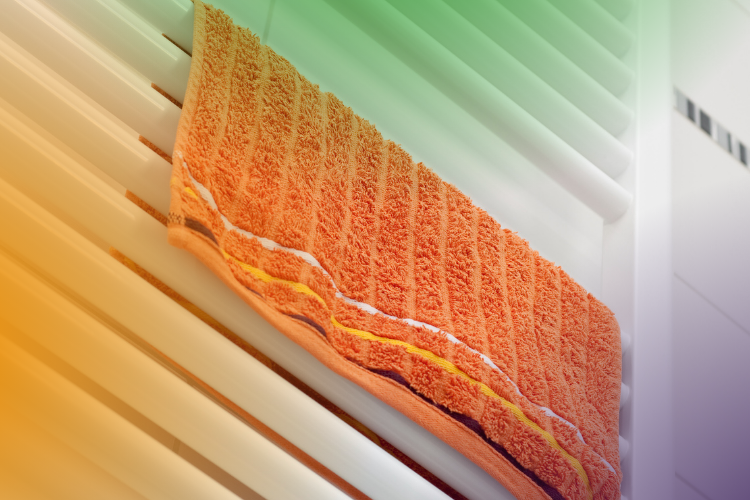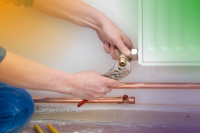Thinking of Investing in Designer Radiators For Your Bathroom?
When you’re planning a bathroom project, radiators have to be considered on two levels. Firstly, the prime function of a radiator is obviously to distribute heat around the room and make being in the bathroom a more pleasant environment. The second thing you’re looking for in a radiator is something to bring a bit of style into your hon, and this is the main reason why homeowners look to the designer end of the market. The range of different radiators is extensive, so whatever style and colour of radiator you are looking for, there will be the perfect model to suit.
Heating and Bathroom Radiators
Before you get carried away looking at the top-end, designer radiators with sleek good looks, it’s important to understand the heating basics first. A beautifully designed radiator which doesn’t heat your home effectively is just not a good choice. Space in the bathroom is often limited which might constrain your choice, but that doesn’t mean the options are a white, rectangular radiator or no radiator at all.
Radiators aren’t just about keeping you warm and comfortable in the bathroom though. Damp and mould can be a huge issue in bathrooms which are left unheated, and which are often poorly ventilated too. Adding in a radiator and keeping your bathroom at a manageable temperature can help keep the mould at bay when combined with other ventilation methods too. Once you’ve established what size of radiator you need to heat your space, you can then start thinking about the design choices.
Bathroom Radiators – Basic Types
All bathroom radiators, whether designer or the cheapest models in your bathroom warehouse, can be divided into three main types. There are advantages and disadvantages of each, and considering these might help narrow the choice.
Standard Bathroom Radiator
A standard bathroom radiator looks just like all of the other radiators in your house. It is plumbed into the central heating system, and will come on and off with the rest of the heating in the home. This can mean however that if your heating switches off altogether in warmer months, you have no heating in your bathroom at all. You can also add a valve to adjust the temperature of that radiator only. These radiators can either take the form of a standard square panel radiator or a heated towel rail; they both work in exactly the same way, the difference being in the appearance only.
Electric Radiators
An electric radiator is a popular choice for a smaller spaces and rooms, and can be cheaper to install too. This is because this style of radiators aren’t plumbed into the system and don’t have water flowing through them, they just plug unto a socket and are heated by electricity flowing through the element inside the radiator. They work independently from your central heating system, but can take a while to heat up if you haven’t installed a timer. You will need an electrician to install this style of radiator, especially in a bathroom when working with electricity in close proximity to water. As with the plumbed-in options, an electric radiator might look like a standard panel, or like a heated towel rail.
Dual Fuel Bathroom Radiators
Dual fuel radiators offer the best of both worlds, as they are plumbed into the central heating system but can also be switched on and off as required. They can however be more expensive to buy and more likely to go wrong, which is why most people stick to a simple plumbed in, or electric model.
What Else Do I Need to Think About When Buying a Designer Bathroom Radiator?
There are lots of other things you might need to think about when getting the right radiator at whatever price point. First think about where you are going to position it, either in the same place as an old radiator which you are replacing, or in a spot where connecting up water or electrics is straightforward. If you are thinking about replacing an existing radiator, measure it before disconnecting and you will be able to quickly narrow the choice of new designer radiators into the ones which will fit. That’s not to say that you can choose a different size or height of radiator; it just means you’ll have to pay a bit more to your plumber for adjusting the pipework.
Capacity of the radiator is another term which you should be familiar with, and this refers to the output, or heating “power” of your unit. All you really need to know is that the higher the number of British Thermal Units (BTUs), the more powerful the radiator. A larger room, with a larger space to heat, will require a radiator with a higher BTU rating than a small downstairs cloakroom. Any radiator or towel rail rated at 1000 BTUs or under might be great for taking the chill off your towels but won’t do much in the way of heating. A plumber should be able to look at the size of your room and quickly recommend the size of radiator you need.
What Do I Look for in a Designer Bathroom Radiator?
After you’ve looked at how you are going to connect up your radiator, where you are going to locate in and what output you need, you should have a decent list of criteria with which to start your search. The other main thing to think about is style, and designer radiators fall into two main camps – traditional and modern.
Modern
Modern designer bathroom radiators don’t just have to be white. Many brands produce radiators in a range of shades, and some will even offer the option of colour matching the paint colour on the radiator to any swatch of your choosing. In a smaller space, a vertical radiator could be a good choice as it takes up less wall space. The only issue you might have with shopping foe designer radiators is that the sky is the limit when it comes to pricing, with some of the most expensive designs coming in at several thousands of pounds. If you spot a designer radiator which is out of your budget then shop around as the chances are that another company is making a very similar product at a much cheaper price.
Traditional
An ultra-modern panel radiator would just look wrong in a Victorian or Edwardian style bathroom in a period property, so shop for more traditional designs for this style of room. Traditionally, radiators were white or chrome, featuring the classic rounded design, exposed pipework and controls. Traditionally styled bathroom radiators also come in electric or dual-fuel options, although you might have to shop around a bit more to find the perfect radiator for your needs. Another option is to head to your local architectural salvage yard where you might be able to pick up a genuine Victorian radiator which can be refurbished for use in your home. Although this is the best way of getting a genuinely antique look, the downside of a Victorian radiator is that they might not perform quite as well as their modern counterparts. When shopping for traditional radiators, choose matching valves to complement the appearance of the unit.
Online or in the High Street?
Online shopping is undeniably easier than trekking around the showrooms, but there’s a lot to be said for being able to see products “in the flesh” before buying them. Seeing products also makes comparisons easier, and allows for easier comparison of textures and finishes. However, prices are often cheaper online, and you may be able to source from a wider range of retailers than you have in your home town. Online returns can be problematic though if your radiator arrives damaged, or not what you were expecting. There are no right and wrong answers here; the best approach is probably to look both online and in person, get a real flavour for all of the products which are suitable for your requirements and then choose the most convenient way of purchasing.
Installing Designer Radiators in your Bathroom
Designer bathroom radiators are really no more difficult to fit than any other style of radiator, but it’s important to have a plumber who knows what they are doing and who has fitted that particular style before. Often, the retailer will be able to recommend installers when you make your purchase, but if you’re thinking about sourcing your plumber separately, send a link to the products you have chosen when asking them to quote for the job. It’s good practice to get at least a couple of quotes to compare when you are doing any work around the house. Plumbers and other tradespeople are more interested in taking on larger jobs, so you are more likely to be able to strike a good deal if you are getting the same person in to rip out the whole bathroom and install a new one.








